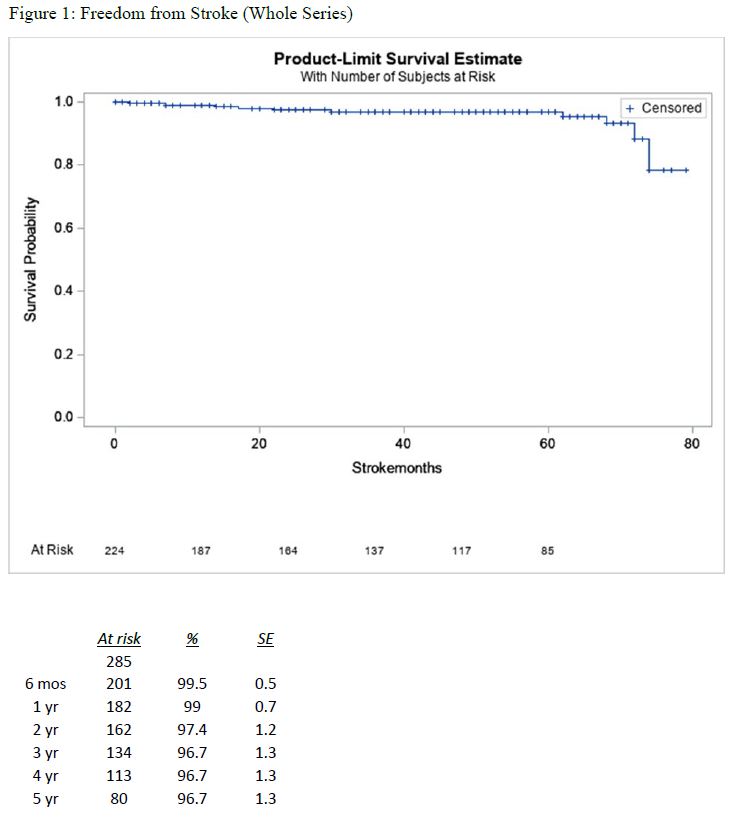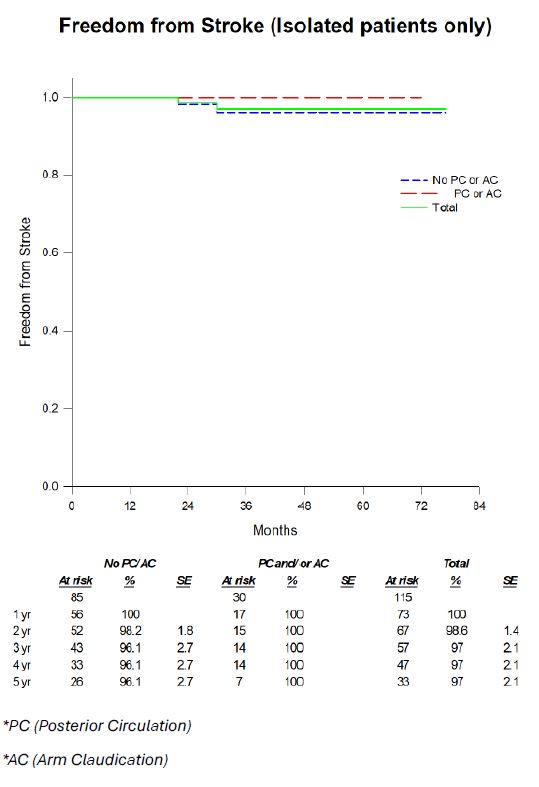Back to 2024 Posters
Late Clinical Outcome/Neuro Events in Asymptomatic versus Symptomatic Isolated Subclavian Steal
Ali F AbuRahma
1, Christina Veith
2, Noah Dargy
2, Robert Cragon
2, Suy Sen Hung Fong
2, Scott Dean
2, Elaine Mattox
2 1Charleston Area Medical Center/West Virginia University Charleston Division, Charleston, WV;
2Charleston Area Medical Center Health Education and Research Institute, Charleston, WV
Background: Natural history of subclavian steal (SS) is not well defined. This is the largest study to date, to analyze late neuro events of patients with asymptomatic (asx) vs symptomatic (sx) isolated SS in over 5-year period.
Patient Population/Methods: SS detected during 11,762 routine carotid duplex ultrasound exams (CDUE) done over a 2-year period were analyzed. Late neuro events including TIA/stroke (hemispheric anterior cerebral vs posterior stroke) were recorded for isolated SS (no associated carotid disease). Kaplan Myer analysis for freedom from stroke for isolated sx (posterior circulation symptom/arm claudication) and isolated asx SS patients and for patients with combined SS and carotid disease was done.
Result: 285 SS were detected during 11,762 CDUE, 191 had retrograde vertebral flow (complete steal) and 94 had bidirectional flow (partial steal), 64% on left and 33% on right. Indications of CDU testing included: post CEA/CAS surveillance 27%, surveillance of carotid stenosis 45%, asx carotid screening/bruit 8%, hemispheric neuro symptoms 9%, arm claudication/posterior circulation symptoms 12%. 115 (40%) had isolated SS and 60% were associated with >70% carotid stenosis. The mean systolic arm pressure differential was 32.4mmHg in the whole series and was 31.8 vs 34.4 for asx vs sx patients, (p=0.537). Mean systolic pressure for patient with retrograde flow was 105mmHg vs 129mmHg for bidirectional flow and 126.8 for normal antegrade flow (p > 0.0001). 51 interventions were done for sx patients: 27 subclavian PTA/Stent, 5 carotid subclavian bypasses, (for claudication/posterior circulation symptoms), and 19 CEA for associated carotid disease.
At a mean follow-up of 34 months (range of 1-79 months), 10 late strokes were noted in the whole group, however in 115 patients with isolated SS (85 were initially asx and 30 sx), there was 1 TIA and 2 late strokes in asx SS group, both were not posterior strokes (1 lacunar hypertensive stroke and 1 cardiac emboli) and no strokes in sx SS group.Kaplan Myer analysis (including patients with carotid artery disease) showed the rates of freedom from stroke at 1, 3, and 5 years, were 99%, 97%, and 97% for the whole series (Figure 1). The rates of freedom from stroke in the isolated SS group at 1, 3, and 5 years were 100%, 97%, and 97% in the whole series, for patients with no symptoms (posterior circulation or arm claudication) were 100%, 96%, and 96%, and for patients with posterior circulation symptoms and/or claudication were 100%, 100%, and 100% respectively. (Figure 2)
Conclusion: SS in patients undergoing CDUE is rare (2%), the majority of which were asx. Isolated SS had relatively benign course with no posterior circulation strokes up to 5 years.


Back to 2024 Posters